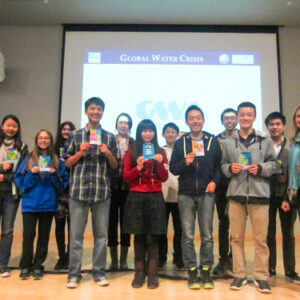Middle school students joined communities worldwide in celebrating the International Day of the Girl Child Oct. 11 – a day which raises awareness about the issues girls face both in the United States and on an international scale. Two years ago, in an effort to recognize girls’ rights and the unique challenges they face, the United Nations General Assembly officially declared October 11 as the International Day of the Girl Child. This year, the theme of the day was “Innovating for Girls’ Education.”
To mark it, middle school student Aliesa Bahri, grade 8, took it upon herself to organize a commemorative event on campus. She urged eighth graders to show their support for the cause by dressing in blue, and asked that sixth and seventh graders wear some type of blue accessory.
“I wanted to raise awareness about girl’s rights … and I chose the color blue since it is typically associated with boys and goes against the ‘pink is for girls’ stereotype,” explained Bahri.
She said she got the idea to organize the event from her affiliation with an organization called The Girls Leadership Institute (GLI), which seeks to help motivate girls to become leaders. Co-founded by educator and social entrepreneur Simone Marean and bestselling author and educator Rachel Simmons, GLI is a national nonprofit providing transformational programs to girls, their parents and their educational communities.
Bahri used the campus’ lunch hour on the Day of the Girl to hold a special video presentation for grade 7-8 students about the plight of girls in Pakistan, where just over half of all girls make it to a primary school classroom, and only 12 percent make it to secondary school.
A large group of students turned out for the video viewing, where plenty of snacks were on hand.
“Aliesa spearheaded the event and worked with me to see what could be done to raise awareness about this important issue,” recalled Cindy Ellis, middle school head.
According to the United Nation’s website, there is overwhelming evidence that girls’ education, especially at the secondary level, is a powerful transformative force for societies and girls themselves. And, while there has been significant progress in improving girls’ access to education over the last two decades, many girls, particularly the most marginalized, continue to be deprived of this basic right.
Ellis cited some shocking statistics about girls, both here and abroad: one in three girls around the world is denied an education; in the developing world, one in seven girls is married before age 15; some 54 percent of girls in grades 3-5 worry about appearance and 37 percent about their weight; 57 percent of music videos feature women portrayed as sexual objects; and only 15 percent of top corporate American jobs are held by women.











